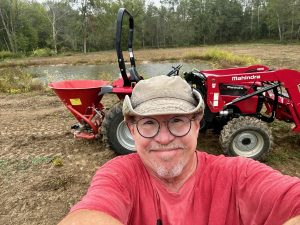Sowing Ryegrass in the Rain
I sowed ryegrass in the rain Monday. It was perfect timing, something that seldom occurs in our venture into hobby farming. Rain has been rare lately, but rain or not, I was determined to plant 50 pounds of seed on my day off. I had borrowed the seeder from a buddy about three months earlier. It was time to return the seeder to its gracious owner, who wants to plant some oat patches before deer season commences. Best not overstay my welcome to using his farm implement.
The clouds looked promising all morning Monday as I went to town, had coffee with a friend, voted early, mailed off a soil sample and stopped by the bank. I got home about noon, quickly changed clothes, and drove the truck down to the shop. I am still having to be cautious with my shoulder five months after surgery, so I learn to adapt. By backing the hopper on the back of the tractor to the truck’s tailgate, I could maneuver the 50-pound bag of seed into the hopper without attempting to pick it up.
A gentle rain began to fall. I lured Pancho the Donkey into his pen with a bucket of sweet feed and locked the gate. We have learned to be hypervigilant since his Great Escape last summer, which necessitated calling out a county posse to corral him. Besides, I learned last year not to let him follow the tractor while seeding, because he eagerly licks up the seed, lowering the crop yield by just a tad. Pancho munched contentedly on the sweet feed, keeping one eye on the tractor as I made it around the pond. Since he is blind in his left eye, one eye is all he’s  got to watch me.
got to watch me.
The rain felt wonderful, slowly soaking me, but no matter. The temperature was in the 70s, the wind brisk, the rain soothing. I always love climbing up on the tractor but especially today, as the seed whirred out of hopper. With luck — and luck is always a key ingredient in hobby farming — soon Pancho’s Pond will be surrounded by golf-course green ryegrass, alleviating the need to buy him bales of alfalfa at $38 a pop. Pancho plows through a bale in about 10 days. Alfalfa is so dense that the feed store fellow uses a forklift to plop it in the pickup bed, and I roll it into the tractor bucket to deliver it to his pen.
Upon the advice of another buddy who is a retired county agent, as soon as the ryegrass is up, I need to fertilize it. “No telling what type of grass might pop up with some fertilizer,” he told me. I suspect this is sound advice.
Earlier that day, as I mentioned, I mailed off a small sack of soil to the Texas A&M Extension Service lab, along with a check for $12. The lab will soon email an analysis, helping me — with the assistance of my ex-county agent friend — figure out what type of fertilizer to apply. Last year, I made a typical rookie mistake and planted the ryegrass seed too thickly. It choked out anything else that might have sprouted except for goatweed and jimson, neither of which are desirable fodder. This spring, I will plant Bermuda in hopes of getting a permanent grass in place.
It took about an hour to spread 50 pounds of ryegrass. I pulled the tractor out of Pancho’s pasture and opened the gate to let him out of the pen. He snorted and walked away, a bit miffed at being confined so long. I spent another 30 minutes hosing the mud off the tractor, cleaning the seeder, and washing the mud off my boots.
By then, I was soaked to the skin as the rain continued to fall. It felt wonderful.
Leave a reply
Fields marked with * are required











